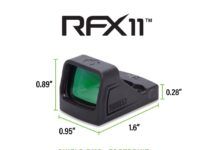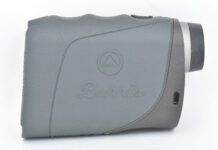Low-power scopes with illuminated reticles bridge the gap between close-range red-dot sights and high-power scopes. These scopes are built with ARs in mind, but could be used on other types of rifles. We recently tested a trio of these dual-use optics, which were compact, lightweight, employed a 30mm tube with a small objective lens, and featured an illuminated reticle. The distinctive differences between them were the reticles. The players were the Leupold Model VX-R Patrol 1.25-4x20mm, $580; Hi-Luxs CMR 1-4x24mm, $400; and the Millett DMS-1 1-4x24mm, $405.
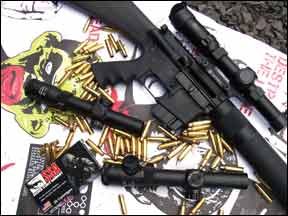
All three scopes featured a fast-focus ocular lens, came with a battery, wore a matte black finish, and had some magnification. The Millett and the Hi-Lux came with flip-up lens covers that allowed use of the fast focus on the ocular lens housing. The turrets for all scopes clearly indicated adjustment direction. Before any lead was fired downrange, we went through our usual battery of tests.
With the illuminated reticle turned on we whacked the scopes on a wooden bench to determine if a jolt would have an effect, slamming both the objective and ocular with enough force to drive a roofing nail. The scope reticles remained lit and turrets and magnification rings operated. They were then subjected to a deep freeze (-4 F) and then soaked in hot water to see if seals leaked. The Hi-Lux and the Leupold do not have turret covers; the Millett does. We kept the turret covers on the Millett so not to give the other two scopes an advantage. The scopes were unfazed by the cold, with controls working with ease. Fogging was anticipated when they were removed from the freezer to room temperature, and all three fogged slightly, giving a milky view that still could be used effectively. The Millett took the longest, about 5 minutes, to completely clear. When placed in hot water, the Hi-Lux expelled a string of bubbles from the magnification ring and illumination knob. We anticipated the worse, but found the Hi-Lux to be fine. There was no water in the scope to be seen and controls worked perfectly. The Millett spat out a few bubbles from the turret caps, but like the Hi-Lux was unaffected. The Leupold expelled no bubbles. The reticles stayed lit during the soaking.

All scopes had the same resolution, with a clear view up to the very edge of the lens. No scope seemed to have an advantage with color/contrast. It was during the brightness test at dusk when the Leupold showed its stuff. It by far used the most light and provided the most brightness, our testers agreed. The Hi-Lux came in second, then the Millett.
We did note that the Leupold and Millett reticles, when not illuminated, were the easiest to employ because of their thick, black crosshairs. The Hi-Lux had much finer crosshairs, and when not illuminated, took more time to see. The three scopes showed a signature at night that was apparent downrange when viewed head on. A slight red glow could be seen from the Leupolds and Milletts objectives; we could see a green glow from the Hi-Lux. Reticles were adjusted across a grid and brought back to zero with no issues. All three scopes passed the non-shooting tests, so they progressed to range testing.
Range time was broken into two segments. First was close-range shooting at 50 yards, and second was precision shooting at 100 yards. We shot with and without the reticle illuminated. Close range consisted of what we dubbed the Romero Routine. With zombie targets at 50 yards, the rifle was shouldered with the muzzle pointing down at about 45 degrees, then the shooter raised the barrel and squeezed off two shots as fast as he could into the cranial area of a Zombie Industries (ZombieIndustries.com) target. George Romero directed Night of the Living Dead in 1968, and from this cult classic we all know only head shots kill zombies. Then, from a benchrest at 100 yards, we shot the box to check tracking and return to zero. We also checked point of impact by shooting at minimum and maximum magnifications. Zombies at 100 yards were also on the agenda.
A Stag Arms Model 7 (StagArms.com) flattop in 6.8 SPC was used with a Leupold Mark 2 IMS (Integral Mounting System) with 30mm rings for all scopes. The Mark 2 IMS provided the correct height needed for an AR. Ammo consisted of Silver State Armory (SSArmory.com) cartridges loaded with 110-grain Nosler AccuBond bullets that zipped at 2550 fps. The combination of rifle, ammo, and any of the scopes were a good setup. They worked like a team. The scopes, which are all close in length and weight, balanced nicely on the rifle, placing weight between a shooters hands. Testers felt any of the scopes would work and work hard, but it was the subtle details of each scope that tipped the ratings. Heres what we discovered once the brass cooled.
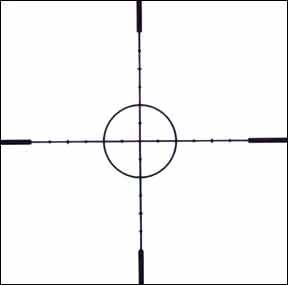
Leupold Model VX-R Patrol 1.25-4x20mm, $580
The VX-R Patrol was packaged with a hex wrench to zero the turrets. The turrets were clearly marked and easily turned by hand. The magnification ring had a knob and coarse ribs to facilitate gripping during rotation. The ring included an indicator used to align with the magnification settings on the ocular lens. Rotation was about 45 degrees from 1.25x to 4x and could easily be viewed with the rifle shouldered. The quick-focus feature was simple to use and appreciated by users on all the scopes. The button that activated the Leupold was easy to use and took no effort to activate compared the Millett and Hi-Lux. A shooter could easily switch on the reticle while aiming. Keep pressing the button and the red dot glows brighter. Holding the button for 5 seconds turns off the reticle. The knobs to activate the Millett and Hi-Lux took more effort to operate, and with practice could be turned on while aiming at a target. The Leupold reticle has an automatic stand-by mode built in. The Motion Sensor Technology automatically switches to stand-by after 5 minutes of inactivity. A motion sensor immediately turns on the reticle to the last setting when the rifle is moved. Users who forget to power off devices appreciated this feature.
The VX-R reticle is called a Fire Dot SPR (Special Purpose Reticle) and is made up of a duplex crosshair with large and small tic marks on the fine horizontal and vertical crosshairs at 2.5-milliradian increments. At 5 mils, the tic mark is slightly larger. At the center is a 10-mil circle, with the red dot appearing in the dead center. With the illumination intensity set on the lowest setting, the dot diameter is the same size as the crosshair. The reticle-holdover tic marks are calibrated for 5.56mm NATO and 7.62mm NATO ammo, but can also be used with other calibers of similar bullet weight and velocity. This and the other reticles have ranging capability that help shooters judge distance, which a vital part of the shooting equation. Maximum power is required for VX-R to use its range-estimating capabilities. If the reticle contains the brisket and rump of a whitetail or mule deer, the animal is at 100 yards. On zombies, the horizontal tic marks within the circle of the reticle bracketed the shoulders at 100 yards. Of course, deer and zombie body sizes vary. If the undeads head is at the top of the circle and its feet are at the bottom, the range is 200 yards.
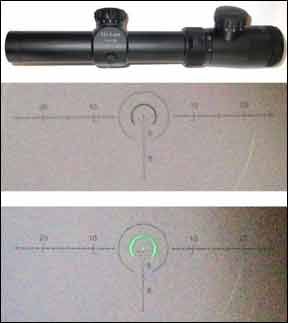
At close range using the illuminated reticle, the VX-R easy helped us pick off zombies, though it took slightly longer to place the dot on the head than it did with the illuminated circle/dot of the Hi-Lux and Millett. Increasing the illumination intensity helped solve the problem for some shooters. At longer range, the Leupold shined as the dot was fine and did not obscure the target. It and the others tracked as advertised and returned to zero. None of the scopes had a shift in impact on low/high magnification.
Our Team Said: Points were given for the auto turn-off feature and the easy-to-use power button. The pinpoint red dot was precise and did not cover the target, while the crosshairs were thick and easy to pick up even on dark surfaces. Testers also liked that magnification rings short rotation to quickly increased/decreased power. The ability to range targets and the holdover for distance were pluses, too. The higher cost will be an issue for some shooters, but in terms of performance, the Leupold was our pick.
Hi-Lux CMR 1-4x24mm, $400
The CMR (Close-Medium Range) optic came with a hex wrench used to zero the turrets, which were clearly marked and easily turned by hand. The turrets feature ZRO-LOK, which locks the zero in place but still allows one full turn of the turret each way for tuning elevation and half turn each way for windage. A Tri-center coil-spring tension system is designed to keep tracking adjustments precise. The magnification ring had a fine ribbed knob and ring. Settings could be aligned with an arrow on the ocular lens housing. Rotation was about 180 degrees from 1x to 4x, with half-power increments indicated. An aftermarket kit can be purchased to attach an extended knob on the power ring. The reticle was a bit of a math problem to some shooters until they understood how it worked. It was similar to a German #4 reticle with a horizontal crosshair and a partial vertical crosshair in the 6 oclock position. The Millett uses a similar setup. These types of reticles give an unobstructed view above the horizontal, allowing for an uncluttered, full view of the target. At the center of the CMRs reticle is a 1-MOA dot surrounded by 5-mil circle surrounded by a 10-mil circle. Open sections of both circles are at 6 oclock and measure 3 mils. The tics on the horizontal crosshair are placed at every 1, 5, and 10 mils, and the height of each of those tics is 1/2, 1, and 2 mils, respectively. Every 10 mils is indicated numerically along the horizontal stadia. On the vertical crosshair, tic marks indicate holdover, the 5 indicates 500 meters (546 yards) and 8 for 800 meters (874 yards). The holdover is calibrated for 62-grain 223 Remington and 168-grain 308 Winchester rounds. A 19-inch target frame, which is the width of an adult deers brisket or the shoulder width of an adult zombie, is built into the horizontal. The distance between the left and right 10-mil tic indicators measures 19 inches at 25 meters. To work this scope, testers noted that they would invest in some range time and use a a Sharpie to write a cheat sheet on a piece of masking tape and affix the tape to the stock or scope. The reticles crosshairs were the finest of all three scopes. The CMR reticle is illuminated via a knob on the ocular lens housing that took effort to turn. The Milletts knob was the same, with both more clumsy than the Leupolds push button. The knob for both the Hi-Lux and Millett could be turned in either direction, and some shooters accidentally unscrewed the Hi-Luxs battery cover, which had a knurled edge. The Milletts cover had a smooth edge. The solution was to tighten the battery cover with a coin and turn the rheostat knob in the opposite direction of the cover. The dot and small circle of the reticle illuminated green with a glow that was pronounced at high intensity and easy to see in sunlight and in dim light conditions. The inner circle/dot was super easy and quick to line up on a zombies head at 50 yards. At 100 yards the outer circle lined up with the zombies torso. With the shoulders and torso in the circle, a center of mass shot was simple.
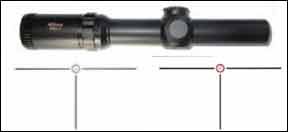
Our Team Said: The fine crosshairs of the CMR took longer for some testers to pick up, and some wanted them slightly thicker. After the initial fright of dealing a complicated reticle, it was deemed effective at short and long range. Some felt the green illumination was easier to pick up than the red. All in, the Hi-Lux performed comparably to the Leupold and cost less.
Millett DMS-1 1-4x24mm, $405
The DMS-1 (Designated Marksman Scope) came with a lens-cleaning cloth. The most visible difference between the Millett and the other two scopes were the turrets. The DMS-1s turret covers needed to be removed to adjust the reticle. In the windage turret cover, a spare battery could be stored, which testers felt was a nice touch. Elevation and windage adjustments could be made without tools; a groove in the turret allowed zeroing. Clicks were precise and audible. The magnification ring had a knob and chunky grooves so the shooter could grip it and rotate it, which it did easily. The magnification ring indicated the settings and could be aligned with a tiny dot on the scope tube. Rotation was about 225 degrees from 1x to 4x with half-power increments indicated. The Donut-Dot reticle was the least complicated of all three scopes. It consisted of a German #4 reticle with 2-MOA thick horizontal and vertical crosshairs. At the center was a 1-MOA dot surrounded by a circle with a 12.6-MOA outside diameter (O.D.) and a 10-MOA inside diameter. At 100 yards at 4x, the O.D. of the circle was 12.6 inches; at 1x the O.D. was 51.6 inches. Going back to our brisket/zombie example, at 3x the O.D. was 18 inches and nicely bracketed the torso. There were no tic marks on crosshairs. You needed to know the power setting to determine distance. The rheostat knob is located on the left side of the tube and is easily turned by hand, but it takes some practice to do it while aiming the rifle. At short range, the reticle was easy to pick up, place on the zombie head, and fire. With the heavy crosshairs, it was the fastest of the three scopes. At 100 yards the Millett was pushing the envelope – the reticle started to obscure the target.
Our Team Said: Testers felt the maximum range of the DMS-1 was 100 yards. This is fine since the test was for a close- to medium-range scope. The ranging features and long-range ability of the Leupold and Hi-Lux gave them an edge over the Millett optic, we believe.

























